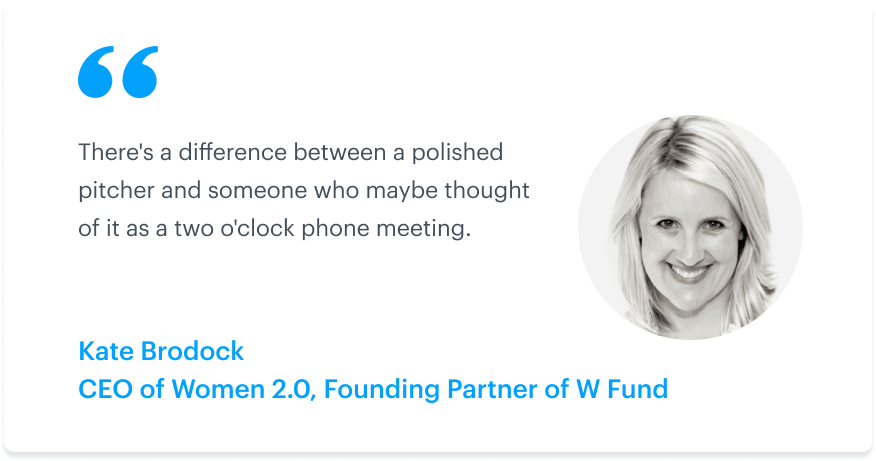COVID-19 restrictions have changed countless aspects of business, including how founders pitch VCs. More than ever, founders are relying on phone calls and video meetings to connect with investors and try to fundraise.
Though remote pitching can be challenging, it’s also a great opportunity to chat with VCs you wouldn’t ordinarily meet in person. You just need the right approach and a strong Internet connection.
Since remote pitching could become the new normal even after COVID-19 dies down, we talked to founders and VCs who have experience pitching—and taking pitches—from afar to get their expert tips on nailing remote pitches.
1. Create a pitch agenda
It’s easier for VCs to get distracted when they’re listening behind a screen, so it’s critical to keep your pitch concise. In fact, at most pitch events, you only get the floor for 5–10 minutes, says Kate Brodock, CEO of Women 2.0 and founding partner of W Fund.
Focus on why your idea or solution has merit, what your needs are, and how you plan to use the money you raise. It’s also important to convey your long-term vision for the company and explain why you’re the best person to execute it, says Jen Neundorfer, founding partner of January Ventures.
Creating an agenda ahead of time can help you stay on track and lead the conversation with ease. Consider including the following in your agenda:
-
Introductions from you and team
-
Introductions from the investor
-
Product demo
-
Financial overview (including how COVID-19 affected your company, if relevant)
-
Goals and fundraising plans
-
Questions and answers
-
Contact information and next steps
You may be tempted to use the entire time to explain your idea, but it’s smart to budget time for other components, like addressing investors’ initial questions, Brodock says.
“It’s a really interesting way to see how fluidly founders can speak quickly to questions,” she says. “It really shows the depth of their knowledge.”
You also want to make “sure there are times built in where you’re not just doing a straight pitch,” Brodock says. Occasionally going off pitch, either by laughing or sharing a quick anecdote, can demonstrate your enthusiasm and help you establish a personal connection with the investor.
2. Tailor your pitch
It’s crucial to speak to an investor’s interest when pitching, says Neundorfer. Having a better understanding of someone’s goals and past investments can help you tailor your pitch accordingly.
“Make sure the investor comes away with a reason to follow up with you,” Neundorfer says. “You don’t need to get into every last little detail, but tell them enough so they’re compelled.”
One of the benefits of a virtual pitch is you have more time to research investors beforehand. “Take advantage of that and the networking ability you get from being able to do the due diligence,” says Breanne Acio, CEO of Sēkr Inc.
You should still prepare to go off-script if necessary, though. To gauge an investor’s knowledge level and interest, Neundorfer recommends asking them how familiar they are with your company or solution at the top of the meeting. Depending on their answer, you can either jump straight into your pitch or provide some background information.

3. Discuss the financials
The most important part of your pitch isn’t the product demo—it’s the bottom line explanation. “It’s really easy to spend time on the story and the product,” Brodock says, then forget to discuss finances.
According to research from Feedback.vc, the strongest predictor of whether a VC wanted an introduction with a founder was the company’s economic potential. The product or solution itself was actually a weak predictor of VC interest.
More than anything, an investor needs to know there will be a return on their investment. That’s why Brodock recommends finding a balance between highlighting your solution and explaining the numbers around market size, growth potential, and profit.
4. Practice your pitch
Practicing your pitch ahead of time is key to success. “There’s a difference between a polished pitcher and someone who maybe thought of it as a two o’clock phone meeting,” says Brodock.
Not only do you have to hit the important points and explain your idea clearly, but you also need to speak with calm and confidence. Writing out what you want to say can help, but don’t rely on a script, says Acio. It’s tempting to read from your notes when you’re pitching virtually, but investors will be able to tell.
It’s also important to practice demoing your product. A virtual pitch is a good opportunity to show someone how your product works rather than just telling them, says Neundorfer. Make sure you know how to share and unshare your screen, adjust your audio settings, or troubleshoot if the connection breaks up.
Before your official pitch try presenting to one or two trusted friends or colleagues first. Ask for constructive feedback on your pitch deck, demo, bottom line explanation, delivery, and ability to answer questions thoroughly.

5. Read the room
When you’re pitching virtually, it’s harder to pick up on context clues. “One of the mistakes we’ll see is people who dive into their pitch and go, go, go, go, go. They’re looking at the slides, not at our reaction,” Neundorfer says.
Remember to pause occasionally, periodically unshare your screen, and give investors eye contact, Neundorfer says. “I think that is a really important way to build rapport and trust.”
It may be more difficult to establish an authentic connection over a virtual meeting, but forging a bond can give you credibility as a leader. If a founder has “the human element and can establish that rapport with me,” Neundorfer says, “chances are they’ll be able to do that with customers and with their employees.”
6. Follow up on your pitch
Your pitch isn’t over once you log off the computer—reach back out to the investors, thank them for their time, and ask if they have any additional questions.
You may also want to provide a copy of your pitch deck and more information about your background and company.
7. Treat every pitch as a learning opportunity
“Pitching is hard and takes practice,” says Acio. Take advantage of this time and set up a handful of remote pitch meetings, whether you meet with investors one-on-one or participate in virtual pitch slams. “Especially in this time where [pitching is] virtual and you have this layer of protection,” Acio says, “do it as much as you can.”
The more you practice, pitch, and adjust your approach, the better you’ll get at presenting your idea and explaining its value to the world, both economic and otherwise.
Pitching behind a screen may seem intimidating, but it’s doable. Focus on creating a good pitch agenda, practicing your delivery, and addressing the economic impact of your solution. You may also want to check out Carta’s Series A deck, which gives you insight into our fundraising process.
